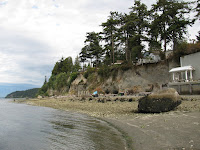


For decades, this beach on the north side of Weaverling Spit has been eroding back into the fill that was placed around the original railroad grade (now the Tommy Thompson bike trail). Pulling back the fill would probably have solved the erosion problem, but would have been hard to sell to the various parties involved. But building a seawall or dumping rock is also hard to sell these days and would have done nothing to restore the beach itself, so folks got together to develop a softer solution.

This nourishment project was completed last month and it seems like a good approach for this site. Sand and gravel was placed on the upper beach, old rock and concrete debris was either carted away or buried, and four anchored log groins (we euphemistically call low groins "drift sills" here - a Wolf Bauer term) were built, although I am not really convinced they are necessary. They add complexity, hard structure, and cost to what might have been a simpler project, but there are also good reasons for including them on some projects.
It will be fun to watch this site evolve - even just over the next few months. Conventional armoring goes in and not much happens visually - after all the purpose of a hard structure is to NOT allow change (many of the impacts of armoring, other than the ones associated with its initial placement, take time to emerge). But nourishment projects are intended to be flexible and like natural beaches, change with storms and seasons. In the process, they tell us much about the factors influencing a site.
Several things will be worth watching. There is already considerable rearrangement of the beach face going on, particularly at the west end where a distinct berm is forming lower on the beach. The stream outfall at the very west end interacts with the new beach and its delta may become a sink for some of the new sediment. There will be some spreading of gravel eastward from the project, although I doubt the volumes will be high. The most important changes will be in the evolution of the berm. Instead of building this project with a natural berm, the sand and gravel were just piled high against the bank. This material will gradually erode and be incorporated into the gravelly foreshore. A berm will slowly develop, allowing logs to accumulate, although logs build up slower on these north-facing shorelines (it's about the wind). The lack of a natural berm and the eroding material from the upper part of the project will keep this from looking like a natural beach for several years, but we should remember that shoreline projects should not be judged over the short-term.
There are some shots from nearby, though not this particular site, at:
Weaverling Spit: September 2009.
And if you want to check out the trail - just note that a fire on the trestle a couple of weeks ago closed the trail east across Fidalgo Bay from Weaverling.















































